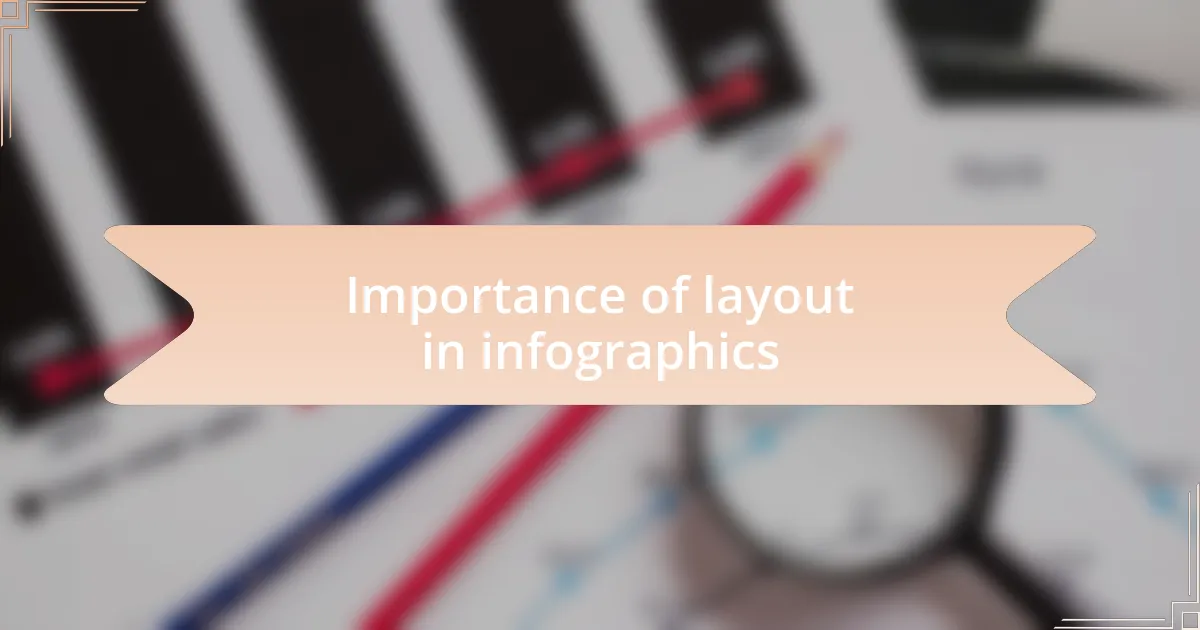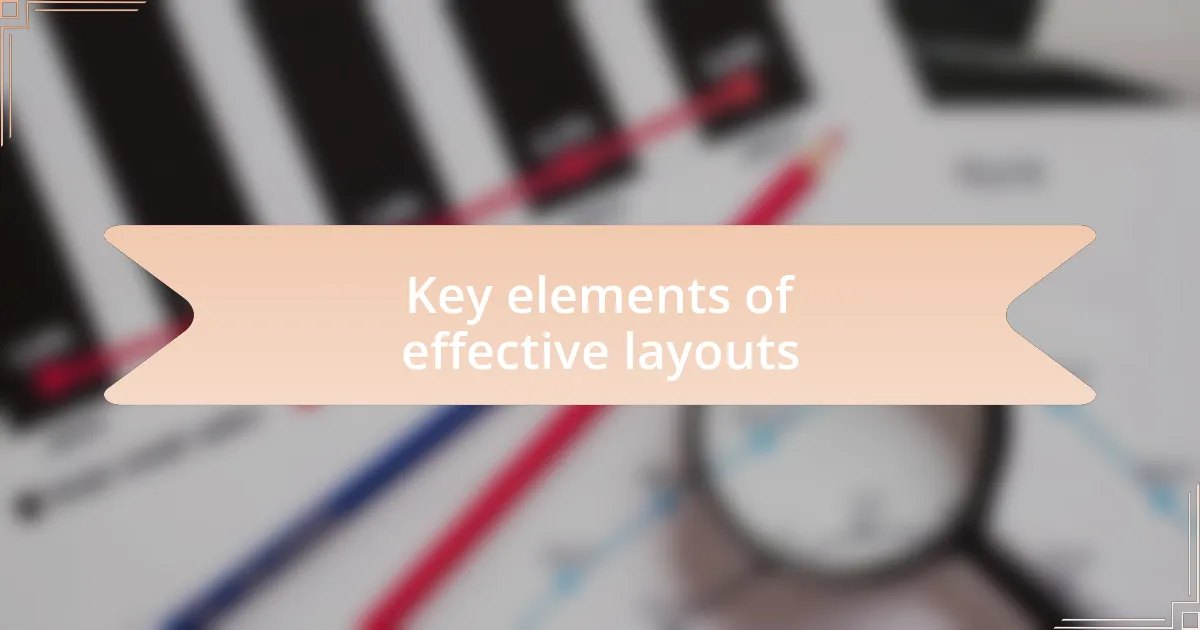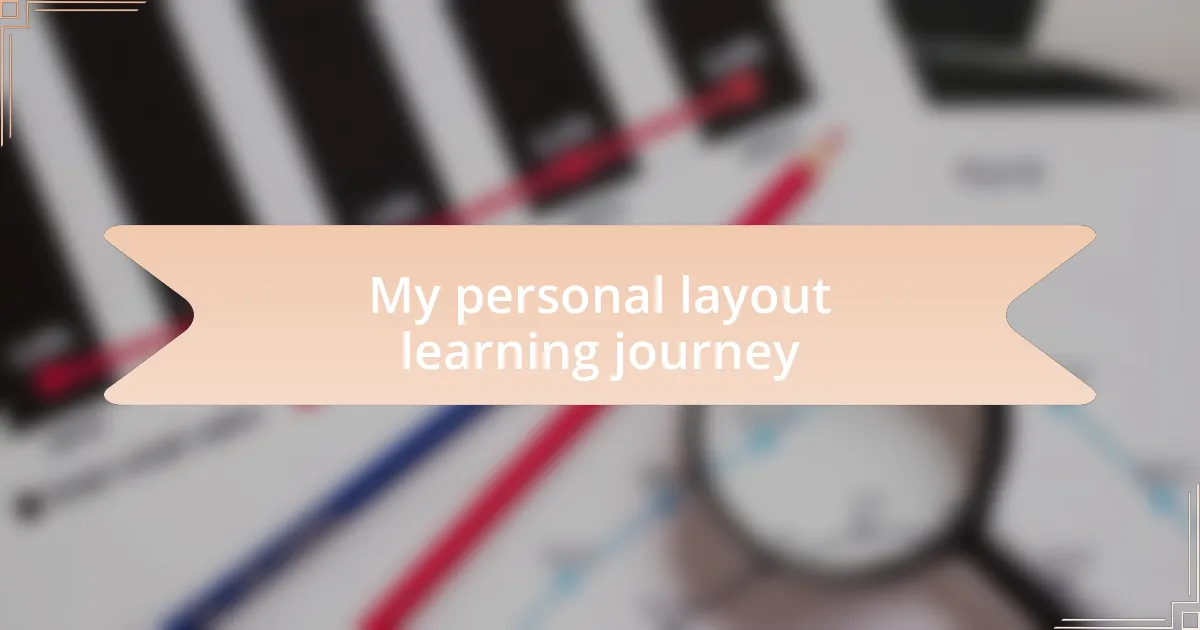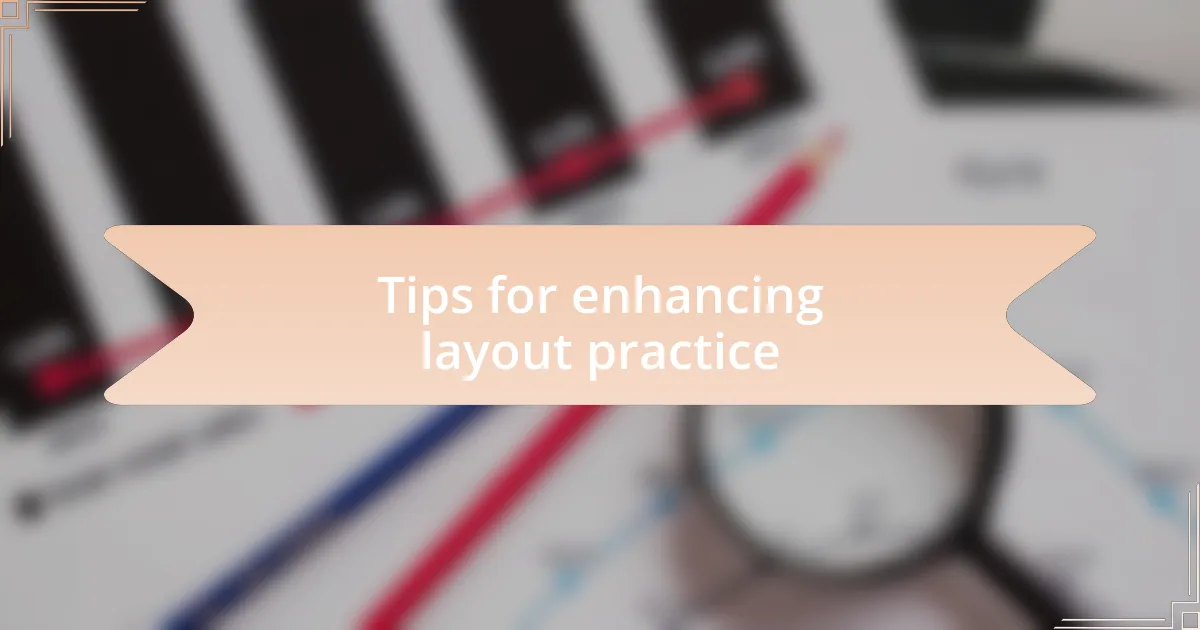Key takeaways:
- Balance and whitespace are essential in creating harmony within layouts, allowing elements to breathe and enhancing overall comprehension.
- A well-structured layout influences emotional engagement and guides viewers through the narrative, emphasizing the importance of alignment and information hierarchy.
- Using design tools like Adobe XD, Canva, and Figma can significantly improve layout skills through improved collaboration, creativity, and streamlined processes.
- Continuous practice, attending workshops, and embracing feedback are crucial for personal growth in layout design, helping refine skills and enhance effective communication.

Understanding layout skills
Understanding layout skills is crucial for creating visually appealing infographics. I remember the first time I worked on a layout – it felt daunting. I kept asking myself why some designs just felt “off.” This inquiry pushed me to explore how elements interact on the page.
One of my key takeaways was the importance of balance. When I shifted elements around in one of my early projects, I found that even small changes fundamentally altered how the information was perceived. This hands-on experimentation taught me that layout is not just about placing items but about creating harmony.
Moreover, I began to appreciate white space as a powerful tool. Initially, I feared leaving areas blank, thinking it would feel empty. However, I soon realized that these spaces allowed other elements to breathe. Isn’t it fascinating how letting things rest can amplify the message you want to convey?

Importance of layout in infographics
Layout in infographics serves as the backbone of visual storytelling. I can vividly recall a project where I underestimated the impact of alignment; my text looked chaotic, and my audience struggled to follow. It was a wake-up call—realizing how a well-structured layout could guide viewers through the narrative made me rethink my entire approach.
Another vital aspect is the hierarchy of information. In one of my earlier designs, I used oversized graphics that overshadowed essential text. That experience taught me that not all elements deserve equal attention. I began to ask myself: how can I make sure the most crucial information stands out? Finding the balance between visuals and text was key to enhancing comprehension.
Let’s not overlook the emotional impact of layout. When I finally cracked the code on using color schemes and spacing effectively, I noticed how much more engaged my audience became. Isn’t it amazing how a thoughtful layout not only conveys information but also evokes feelings, making the story unforgettable?

Key elements of effective layouts
The use of grids is an essential element that transformed my design process. Initially, I would scatter elements haphazardly, thinking a freeform layout would be more creative. However, after trialing a grid system, I discovered how it creates a sense of order and balance. It’s like laying down tracks for a train; everything flows much more smoothly when the path is clear and organized.
Another key component of effective layouts is whitespace. At first, I feared leaving too much empty space would make my designs look incomplete. Yet, I learned that strategic whitespace can actually enhance readability and focus. It was enlightening to see how breathing room allowed the important components to shine—I often ask myself, “What can I remove to make this stronger?”
Lastly, visual consistency is something I now prioritize in my work. Early on, I experimented with various fonts and colors, thinking it would add excitement. Instead, it created visual noise that distracted viewers. By maintaining a cohesive style, I realized I could create a seamless experience that guides the viewer’s eye effortlessly. Have you ever noticed how some designs stick with you? That’s the power of consistency at play, making the message not only clear but also memorable.

Tools for improving layout skills
When it comes to tools for improving layout skills, I’ve found a few that truly make a difference. For instance, Adobe XD became my go-to software for creating wireframes and prototypes. Initially, I was overwhelmed by its features, but once I dived in, I discovered how intuitive the interface is. Have you ever faced that daunting learning curve? I certainly did, but mastering this tool significantly streamlined my design process.
Another valuable tool I’ve incorporated into my workflow is Canva. While it may seem simple, Canva offers templates that can spark creativity and inspire new ideas. I often found myself in a design rut, unsure of where to start. By using pre-made layouts as a springboard, I could break through that barrier and experiment with different styles and structures. It’s amazing how a template can jump-start your imagination, isn’t it?
Lastly, I can’t talk about layout skills without mentioning Figma. Its collaborative features changed the way I approach projects with teams. Being able to get real-time feedback while working on a layout felt revolutionary. I remember a particularly challenging project where my team could share insights instantly, helping us iterate faster and create a more polished final product. Have you ever wished you could gather feedback as you create? Tools like Figma make that wish a reality, enabling a more dynamic and engaging design process.

My personal layout learning journey
As I embarked on my journey to improve my layout skills, I quickly learned that practice was essential. I remember spending countless late nights simply experimenting with different layouts on blank screens. There was a moment when I created a layout that just clicked—everything felt balanced, and I knew I had tapped into something meaningful. Have you ever experienced that exhilarating moment when everything comes together perfectly?
Attending design workshops was another pivotal part of my learning. I was surrounded by creative minds who challenged my perspectives and made me rethink my approach to layout. One workshop, in particular, focused solely on whitespace—a concept I had previously underestimated. The way a simple, well-placed gap could transform a cluttered design into something elegant was a revelation. It made me wonder, how often do we overlook the power of simplicity in our work?
Reflecting on my layout skills now, I realize how much they’ve evolved. I still remember the frustration of getting lost in intricate designs that lacked clarity. But through perseverance and a constant willingness to learn, I’ve come to appreciate the balance between creativity and structure. How has your own journey in layout design shaped your understanding of effective communication? For me, it has become clear that an effective layout is not just about aesthetics; it’s about crafting a message that resonates.

Tips for enhancing layout practice
When enhancing my layout practice, one of the most beneficial techniques I utilized was creating mood boards. This simple activity allowed me to gather visual inspiration, which ignited my creativity. Do you remember the first time you pieced together elements that inspired you? For me, it was like opening a treasure chest of ideas, leading to fresh design concepts.
Another effective strategy I’ve embraced is the habit of critiquing my past layouts. I often revisit old projects to analyze what worked and what didn’t. This reflective practice helps me identify recurring mistakes and successes, fostering continuous growth. Have you ever taken a closer look at your earlier designs? It’s fascinating how much insight can come from examining your own journey; it often illuminates patterns and areas for improvement.
Lastly, I started to embrace feedback from peers and mentors more openly. Initially, I felt defensive about my designs, but I quickly learned that constructive criticism is a goldmine. Each piece of feedback was like a stepping stone, guiding me toward improvement. How has feedback influenced your design process? In my experience, inviting others to weigh in not only strengthens my skills but also broadens my perspective on layout possibilities.